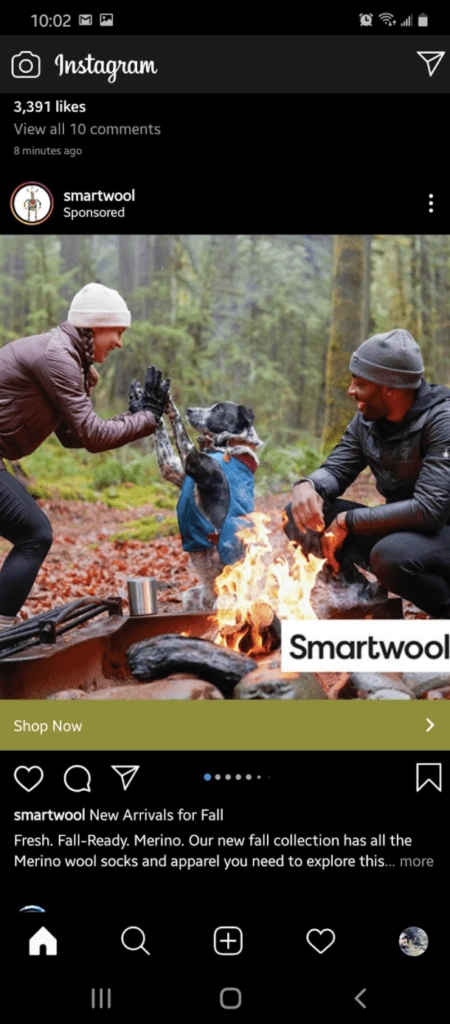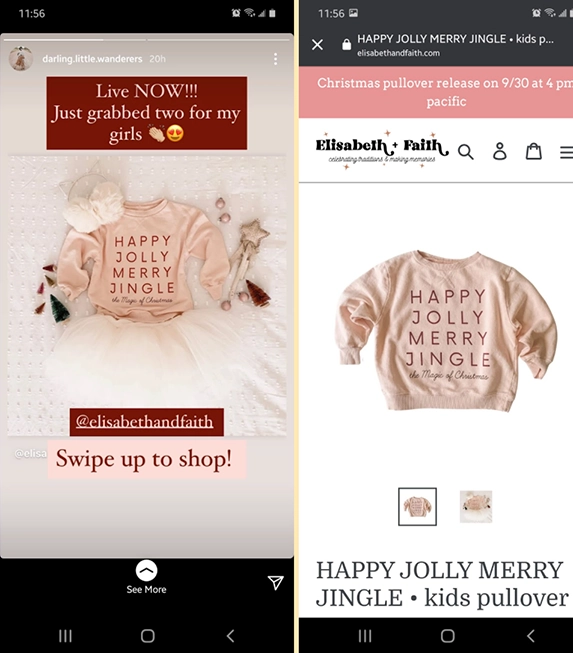Reading Time: 14 Minutes
Social media is not just a place for friends and families to connect – it’s also a marketplace wherein online communities exchange feedback on some of their favorite brands, products, and services. From this ecosystem emerged a new ecommerce trend known as social commerce (S-commerce).
Social commerce is consumers’ ability to shop and purchase products or services inside a social media channel without having to leave the platform to complete a purchase.
S-commerce enables streamlined paid ads, as well as customer word-of-mouth and influencer-sponsored posts. Consumers can respond to offers, recommendations, or media ads within the social media app itself.
The greatest benefit of S-commerce is that it merges online communities (connections, friends, groups, etc.) with shopping. S-commerce provides more opportunities for DTC brands to boost sales more organically using a social media platform itself to do so.
Currently, Instagram is the leading S-commerce platform, but Facebook, Pinterest, and Twitter are not far behind. Even TikTok has introduced S-commerce capabilities for influencers and consumers.
“Just as shoppers want to share and show off their purchases, ecommerce brands are expected to provide a personalized, back-and-forth experience for shoppers. Considering 90% of Instagram users follow at least one brand on the platform, there’s no denying the potential for social feeds to drive sales.”
–Flowbox
The most basic form of S-commerce is the newsfeed ad, as illustrated in the mobile screenshot below courtesy of outdoor apparel brand Serremo:

These ads include a group of images or videos showcasing their products with a CTA to “shop now” or “buy now.” When the consumer clicks on the CTA, the platform immediately directs them to a product display, selection, and checkout.
But S-commerce isn’t only available via social media ads. Social media users can share links to their favorite products, influencers can use S-commerce to promote their favorite brands, and brands can access other features, such as Instagram Swipe-ups on Stories and Highlights.
Full S-commerce capabilities allow consumers to shop and buy without leaving the social media platform. A modified S-commerce strategy involves affiliate links or redirects to a brand’s ecommerce store.
S-commerce is especially popular among DTC brands, but plenty of distributors and B2B companies are also taking advantage of this streamlined approach to social shopping.
S-commerce technology is popular with everything from clothes to mobile apps to electronics to nutritional supplements, and brands are generating powerful results. Recently, Shopify published a social selling case study featuring one of GRIN’s clients, MVMT Watches.
“When people see something they love they want to buy it immediately. It’s really exciting because social commerce is going to be a trend in the future… It’s really important to cut out steps in the purchasing process. It’s almost like having a new landing page, but one customer can purchase from instantly.”
– Spencer Stumbaugh, Director of Marketing at MVMT Watches
S-commerce is a versatile and efficient way to capture new customers in newsfeeds, stories, ads, and sponsored content. There are several different ways that brands are using these posts.
Remarkable announced its next generation presale event on social media using S-commerce technology. Promoting new products and services is a great way to take advantage of S-commerce tools on social media.

Perhaps the most common excuse to utilize S-commerce is to publicize limited-time offers and promotional discounts. Babbel ran a social media campaign offering half-off discounts on their language-learning subscriptions.
This time of year, holiday sales events are filling the social media space as consumers get a jumpstart on their holiday shopping. Due to safety concerns surrounding the COVID-19 outbreak, more consumers are hoping to complete their gift shopping at home from the palm of their hands.
Similarly, brands are using s-commerce to move seasonal inventory at a faster pace. Since shoppers are scrolling through their social media more often than reading promotional emails and patiently sitting through pre-video ads, S-commerce content receives more attention naturally.

Instagram and Facebook stories are just a few of the latest user experiences that open the door to more S-commerce functionality. And because Facebook Marketplace lets you manage inventory on both platforms at the same time, S-commerce has never been easier.

Last but not least, influencers and brand ambassadors are the most affordable and effective ways to scale your S-commerce strategy. These influencer posts are more authentic than branded posts or newsfeed ads.
There are two buyer behaviors that continue to power S-commerce. The first is that ecommerce is shifting toward mobile shopping. Not only is shopping from mobile devices more convenient, but social media and omnichannel technology make the mobile buying experience so much more enjoyable.

Second, buyers demand authenticity. Rather than turning their attention to traditional ads (to include pay-per-click advertising), consumers are relishing products and messaging that promote brand integrity and tell a story featuring a particular lifestyle. Authenticity is what today’s consumers long for, and without it, they are less inclined to buy.
“Eighty-six percent of people say authenticity matters when deciding what brands they like and support. To win the hearts and business of your target customers, you have to convince them you are trustworthy and authentic.”
– Forbes, As Trust Among Consumers Wavers, Authenticity is Critical

Since the two critical trends in consumer spending today are mobile marketing and brand authenticity, few strategies can compare to the integration of influencer marketing and S-commerce.
Influencers and brand ambassadors – two influencer groups that nurture trust with a growing social media audience – are delivering authenticity in ways that brands can’t on their own. That’s why brand-influencer relationships are so effective at delivering high sales and brand awareness with consumers on social media.
If S-commerce has made it easier for ecommerce to grow on social media (and it has), then the effects are even greater for influencer marketing. S-commerce technology allows followers to shop for products promoted by an influencer more easily within the social platform itself.
The s-commerce ecosystem is developing fast. That means that there are increasingly new ways to integrate S-commerce with your influencer campaigns. Here are some of the most popular ways that influencer marketing and S-commerce work together.
One of the leading s-commerce developments in the last couple years is the Instagram Story Swipe-up feature. Influencers are known for creating compelling Story content, and taking advantage of the Swipe-up feature only enhances campaign results.
Consumers can swipe and arrive at a product page. They then select the item they want to buy and checkout in under five minutes.

You can also use affiliate links as part of your S-commerce strategy. This tactic will help you better track your influencer performance and drive traffic to your website. Influencers and brand ambassadors can share their affiliate link in post comments, on their profile, or as a hyperlinked CTA embedded in their post content.
Often combined with affiliate links, discount codes add another level of buyer incentive. You can customize discount codes for each influencer, campaign, or both. That said, coupon codes don’t drive as much website traffic as affiliate links will. When combined with affiliate links, your influencers have more leverage to execute both, increased website traffic and sales.
Instagram takeovers occur when an influencer assumes temporary control over a brand’s Instagram account. These takeover posts show up in the influencer followers’ newsfeeds, generate more awareness, and boost sales. As an added bonus, influencers enjoy using takeovers to increase their following.
Because Instagram Takeovers are rare and unique, they grab audience attention and can improve your S-commerce results from your own branded Instagram page.
Many S-commerce strategies involve paid social media advertising. With influencer whitelisting, the brand assumes control over the influencer’s Facebook Ads Manager account and runs paid ads through the influencer’s paid ad account.
Similar whitelisting strategies also exist on Youtube. But since Facebook Ads Manager includes the best whitelisting settings, this technique is more popular on Facebook and Instagram.
When it comes to techniques that involve assuming control over another person or organization’s social media account, brand-influencer trust must be high. These approaches can be risky, but they usually produce high returns.
When consumers see a product featured by one of their favorite influencers and decide that they want it, the easier you can make the buying experience, the more effective your campaigns will be. Combining your influencer marketing with S-commerce technology will make both tactics more effective. Here are just a few more benefits to integrating these two strategies.
The ultimate goal in your s-commerce strategy should be to decrease what is known as conversion friction, where consumers are ready to take the next step but functional issues get in the way.
S-commerce technology makes it easier for customers to convert. They can graduate from seeing something they like to purchase in fewer clicks, and an integrated approach feels more satisfying to shoppers.
S-commerce technology combined with influencer content generates more brand exposure and audience impact. The sleeker features of S-commerce further enhance influencer creativity and make it easier for consumers to engage.
As effective as S-commerce is on its own, influencer endorsements add an extra layer of authenticity. Because influencers and brand ambassadors have worked hard to nurture trust with their followers, and that trust extends to the product or service the influencer is promoting.
S-commerce and influencer marketing enjoy a special synergy. And brands that scale one can easily scale the other.
Additionally, this synergy demonstrates that S-commerce can increase influencer performance and vice versa. Influencers love these S-commerce features because they allow them to boost commissions and achieve better results on behalf of the brands they love.
As a subcategory of ecommerce, S-commerce is a new fast-growing frontier for DTC businesses to increase their digital footprint and grow their brand. Influencer marketing currently stands as one of the most effective ecommerce marketing strategies, generating an 18 times ROI among experienced influencer marketing ecommerce brands.
In many ways, S-commerce is the future of ecommerce and retail as a whole. By understanding how S-commerce works and integrating it with your influencer campaigns, you’ll grow your brand exposure and increase sales at a rapid pace.
Learn more about influencer marketing: Influencer Marketing 101
Our team keeps a finger on the pulse, so you’re always working with the latest information.